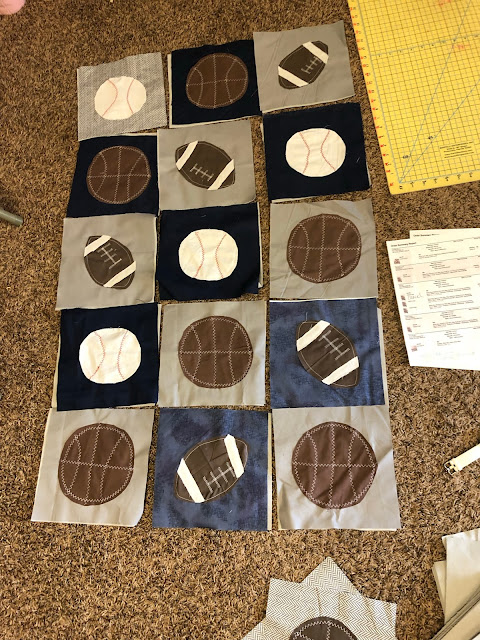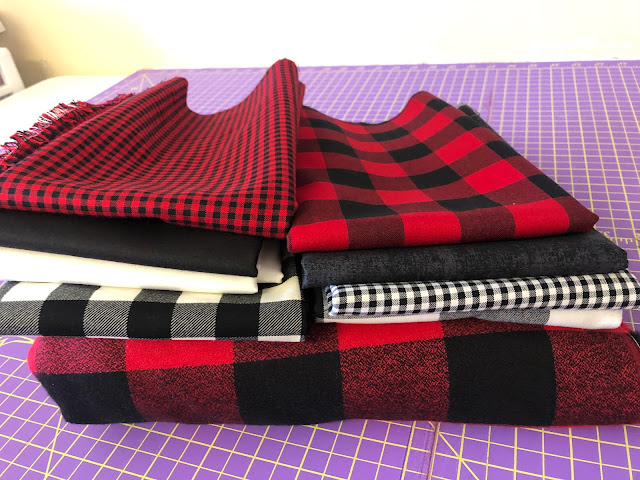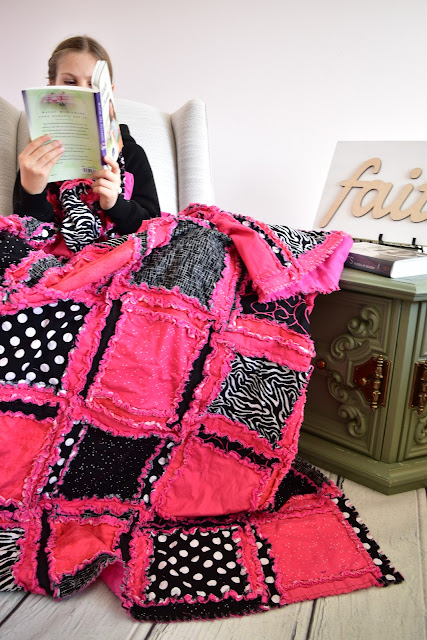The type of fabric you choose for your rag quilt is very important. The frayed edges, and washing the quilt AFTER you’ve assembled and BEFORE using it, make rag quilting very unique. So here are a few tips on choosing the right fabrics, and why.
To choose the best fabrics for rag quilts, or to see if you have the right fabrics for your rag quilts here are a few characteristics of good rag quilt material:
• 100 percent cotton. Cotton fabric frays. Polyester fabric does not. If you want your exposed seams to fray and get really fluffy, then you will want to choose 100 percent cotton fabrics. How do you know if the fabric is 100 percent or not? Look at the top of the bolt for the fabric content. If it says 100 percent cotton, you are good to go.
If you love a fabric that is not 100 percent cotton, it will be ok! But keep in mind that wherever that fabric is in your quilt, it will not fray. The flannel underneath it, and the cotton fabrics surrounding it, will all fray and get really fluffy. But the non-cotton fabrics, especially polyester, will not.
This includes Minky, fleece, and broadcloth fabrics. They will not fray at all, but if you don’t mind that your exposed seams are not fluffy, then go ahead and use these fabrics. If you REALLY want a Minky back to the quilt, check out the best method for adding one.
• Softness. When I am snuggled up under a quilt, I want it to be soft and cuddly. When choosing fabric in your local quilt shop, make sure to get a feel for the fabric, and not just the looks of it.
• Colorfast fabric. I can’t tell you how many quilts I have ruined over the years because I bought a cheap fabric, thinking I needed to save a buck, then saw that one fabric bleed into all my other fabrics after my beautiful quilt was sewn together and washed. Red fabrics are the worst!
But I will tell you my little secret for avoiding the dreaded fabric bleed: Buy designer fabrics. Riley Blake is my favorite, but you can also use Cloud 9, Moda, Art Gallery, Windam Fabrics, Robert Kaufman and others. They are all amazing quality, but more important, when I’ve used these fabrics, they have never bled. Not once.
If you are shopping in a big box store and find the fabric that you can’t live without, give that fabric a couple of good prewashes before you put it in the quilt. After the quilt is finished, throw in a color catcher when you wash it, especially the first two or three times.

• Flannel or cotton? Contrary to popular belief, flannel fabric is not the only fabric one can use to make a rag quilt. Flannel frays amazingly well, but quilting cottons also fray pretty darn well too.
For all of my rag quilt tops, I use a combination of flannels and cotton fabrics for the top layer of the rag quilt. I actually prefer to use only cotton fabrics for the tops of rag quilts. Flannel fabrics that have designs on them seem to look dull after a few washes, and begin to look not as bright as the rest of the cotton fabrics in the top of the quilt. I’ve seen flannel fabrics (especially discount flannel fabrics) begin to look very worn after being washed only a handful of times. After putting in all that time and money to make a beautiful quilt, I would get discouraged if the quilt began to look old after using it only a couple of times. So I try to stick with quilting cottons for the top of the quilt.
For the back of the quilt, I use solid flannels. I’ve found that the majority of the time, even inexpensive solid flannels hold their colors and don’t fray or peel as much as the flannel prints. Plus, flannel solids are available in a huge assortment of every color of the rainbow, with many colors in between. My absolute favorite brand is Robert Kaufman for flannel solids and we carry them in our online fabric shop.

• Quality. I am sure you’ve heard a million times that it is best to buy designer fabrics from your favorite quilt shop. I tend to lean to this opinion. I have made so many quilts over the years, and the quilts with the designer fabrics from the brands we all know and love have held up the best.
But, I have also found some very beautiful, quality fabrics at the big box stores, and these also have held up through the years. When you are choosing fabrics, take time to run each fabric through your fingers and make sure it feels nice. Look at how tight the weave is; if it is loose it will not hold up very well. Hold the fabric up to see how well it drapes. If it is really stiff and doesn’t drape well, then it probably will not be comfortable to snuggle up with.

Choosing the right fabrics for your rag quilt is very important if you want a long lasting quilt to treasure for yourself or to give to a special person, especially when you put so much time, effort, and money into making such a unique and beautiful quilt.
Make sure to check out all of the rag quilting resources on our blog, including which scissors to choose, walking feet, how to wash a rag quilt, rag quilting seam allowances, a wide variety of quilt patterns, and more!







.png)

















.png)